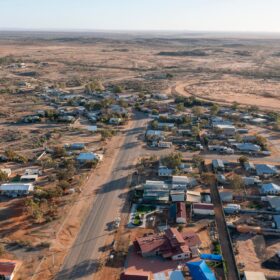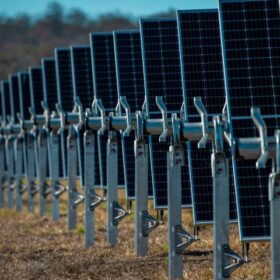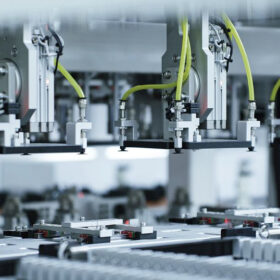Top News
NEM dispatchable capacity CIS Tender 8 opens, targets 16 GWh

Connected and islandable microgrid project launched in New South Wales

Tindo’s road ahead paved with funds, challenges and future-proofed growth
Out now - pv magazine Global November Edition
pv magazine Webinar

New renewable generation capacity in 2025 on track for 7 GW: report

JinkoSolar achieves world record efficiency of 27.79% for TOPCon solar cell
First Graphene and Halocell seal deal on graphene-based carbon paste
Ampyr inks $300 million long term agreement for Bulabul BESS
Distributed energy resources test lab opens in Western Australia
Press Releases
AEMO prepares energy systems for upcoming hot season
WA launches $50 million local battery manufacturing program
EcoFlow Secures CEC certification, marking strategic entry Into the Australian renewable energy market
Queensland’s first Mobile Renewable Energy Training Facility: Powering skills for a sustainable future
Opinion & Analysis
Featured
Misleading chart overstates clean energy challenge
How mandatory climate reporting is raising the bar for corporate leadership
Around the world, businesses are entering a new era of accountability. The shift toward mandatory climate-related financial disclosures is transforming how organisations understand and govern key drivers of financial performance.
Coalition’s net zero retreat: Policies on line
In 2021, Australia’s Coalition government pledged to reach net zero by 2050. Four years later, the Coalition have reversed course. After successive election losses, the Liberal and National parties have settled on a new climate strategy: give up on net zero and keep coal plants running longer.
How Pacific nations plan to go from spending up to 25% of GDP on fossil fuels to running on 100% renewables
Picture dusk falling somewhere in the Solomon Islands. A fisher’s skiff glides home using a whisper-quiet electric outboard motor. In the Cook Islands, a big battery steadies the island grid. In Papua New Guinea’s highlands, solar kits bring electric light to homes for the first time.
Three hours of free power sounds great – but it could raise other costs and hamstring rooftop solar
It was the news that rippled around the nation – and then the world: at least three hours of free grid-supplied electricity for Australian households, every day.
Why resilience won’t future-proof Australia’s supply chains
The last five years have placed unprecedented strain on global supply chains. Geopolitical tensions, trade wars, natural disasters and the global pandemic have revealed vulnerabilities across industries.
Markets & Policy
Featured
FRV seeks federal tick for NSW solar farm and beefed up battery
Engie breaks ground on South Australian battery
French-owned energy group Engie has commenced construction of a new large-scale battery that is says will deliver more capacity and flexibility to the South Australian electricity grid.
WA plans 10-hour flow battery install to boost power reliability
The Western Australia government is looking to deploy a vanadium flow battery energy storage system with up to 10 hours of discharge capacity to help improve regional power reliability in the state’s Goldfields region.
Sinovoltaics updates financial stability ranking for battery manufacturers
The quality assurance service provider’s latest financial stability ranking has Tesla, Mustang Battery and Solid Power in the top three spots again, in a report that tracks manufacturers’ Altmann-Z scores over the past three years.
Potentia lands federal approval for NSW solar and storage project
Potentia Energy has reached another renewables milestone with its 1 GW Tallawang solar and battery energy storage project proposed for construction in western New South Wales awarded unconditional federal environmental approval.
Genesis reaches financial close on 114 MW solar farm
New Zealand power company Genesis Energy has pressed go on its 114 MW Edgecumbe Solar Farm project on the nation’s North Island with the facility expected to start generating power in 2027.
Installations
Featured
ChasingLight Technology launches indoor organic PV modules
Sigenergy points to installation practices for product recall
Sigenergy says the issue that has prompted a voluntary recall of the company’s 8 kW, 10 kW and 12 kW single-phase inverters in Australia and New Zealand stems from incorrect installation practices, not a product defect.
Octopus awards key contracts for hybrid solar and battery project
The Australian arm of British renewables developer Octopus Investments has awarded key contracts as it pushes ahead with construction of a $900 million hybrid solar and battery energy storage project in southern New South Wales.
Hydro Tasmania seeking 1,500 GWh new solar, wind
Hydro Tasmania is seeking to increase its renewable energy generation to meet growing energy demands and support the state’s industrial expansion.
New handbook guides landholders on negotiating solar hosting deals
How to negotiate fair agreements for landholders potentially hosting solar farms, such as bargaining for project designs that enable grazing or cropping, is outlined in a new handbook targeting rural and regional communities.
South Australia installer milks the sun to power advanced robotic dairy
South Australian clean energy systems installer My Energy Engineering has powered an advanced robotic dairy with an off-grid solar array and containerised battery storage system for reliable round the clock energy.
Technology
Featured
UNSW team tests current solar cell architectures for space applications
Longi reveals details of world’s most efficient silicon solar cell
In a new scientific paper, the Chinese solar manufacturer explained that the 27.81%-efficient hybrid interdigitated back-contact cell it unveiled in April is based on passivated tunneling contacts and dielectric passivation layers, while also incorporating both n-type and p-type contacts.
1414 Degrees progresses battery storage development at Aurora energy precinct
1414 Degrees is progressing the development of a battery energy storage system at the Aurora Energy Precinct in South Australia, for the joint venture SiliconAurora, and is independently developing a long duration thermal energy storage facility, with eyes on providing firmed power for data centres.
Longi reveals details of world’s most efficient silicon solar cell
In a new scientific paper, the Chinese solar manufacturer explained that the 27.81%-efficient hybrid interdigitated back-contact cell it unveiled in April is based on passivated tunnelling contacts and dielectric passivation layers, while also incorporating both n-type and p-type contacts.
Fox ESS compact batteries heed rebate call backed by new local teams
Fox ESS is ramping up its presence in Australia with nationwide sales and techical support teams and is building local warehousing for its suite of inverters, electric vehicle chargers, and battery storage products, such as the EQ4800 and new CQ6.
GoodWe releases new residential all-in-one storage solution
The Chinese company says that its new ESA series is available with a hybrid inverter ranging from 3 kW to 10 kW and storage capacities of 5 kWh to 48 kWh. The IP66-rated product supports an MPPT current of up to 20 A on the PV side and allows 200% PV oversizing, according to the manufacturer.
Manufacturing
Featured
Sinovoltaics releases new PV inverter manufacturer financial stability ranking
Phono launches 475 W back-contact panel in Australian market
Chinese manufacturer Phono has launched a new bifacial solar panel in the Australian market featuring an output of 475 W and a power conversion efficiency of 23.27%.
Sinovoltaics updates solar module manufacturer financial stability ranking
The quality assurance provider reported India-based Insolation Energy, Waaree Renewable Technologies, and Solex Energy retained the top three positions in its Altmann-Z score-based quarterly ranking. Its analysts noted the number of companies with healthier scores increased from nine to 11.
Li-S Energy gets funding boost to advance battery manufacturing facility
Battery technology developer Li-S Energy has secured almost $8 million in federal government funding to advance planning for a large-scale lithium-sulfur battery cell manufacturing facility in Australia.
NSW energy distributors de-risk transition with new, unified system plan
Three New South Wales energy distributors have collaborated on the state’s first distribution system plan, which they say can sustain five years of energy transition momentum, while waiting for critical transmission infrastructure to be built.
$1 million raise charges up AVESS vanadium flow battery deployment
Australian energy storage technology company AVESS Energy has completed a $1 million capital raise enabling the progression of projects including vanadium flow battery deployment at the Windimurra Vanadium Project.
Energy Storage
Featured
Akaysha provides Waratah update, still opaque on transformer failure
Battery marks TagEnergy’s move to multi-tech player in Australian market
European renewables outfit TagEnergy has advanced plans to build its first big battery in Australia with the signing of major agreements to deliver a standalone four-hour energy storage system in Victoria.
Chinese manufacturers surge ahead in Australia’s battery storage market
About 10 GWh of battery energy storage supply deals were announced at or following All Energy, further contributing to the already rapidly growing market share of Chinese manufacturers in Australia.
Waratah Super Battery transformer failure raises insurance questions
A transformer failure at the 850 MW Waratah Super Battery could trigger multimillion-dollar insurance claims and project delays, illustrating how a single unit outage can escalate at one of Australia’s largest battery projects.
GPG gets federal go-ahead for Queensland solar and battery project
A 290 MW solar farm and 180 MW / 360 MWh battery energy storage system planned for Queensland’s Fraser Coast region is advancing towards construction after being given the green light by the federal government.
Unidentified buyer snaps up Gunning solar and battery project
Project developer Recurrent Energy has capped a busy couple of weeks in the Australian market with the sale of a 250 MW solar and 120 MW battery project in New South Wales to an unidentified European buyer.


